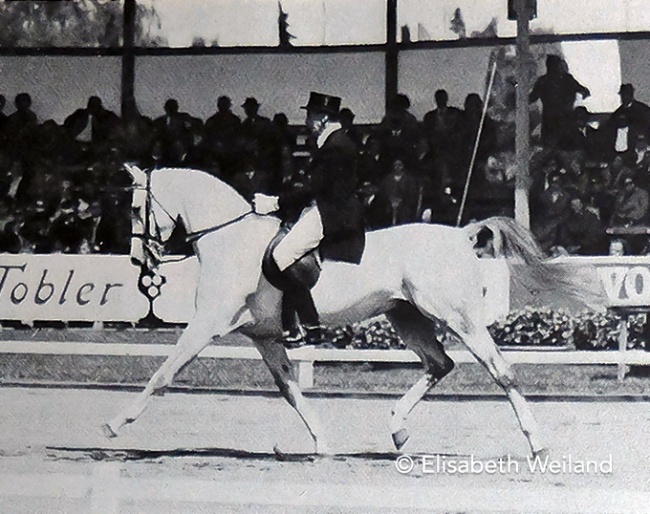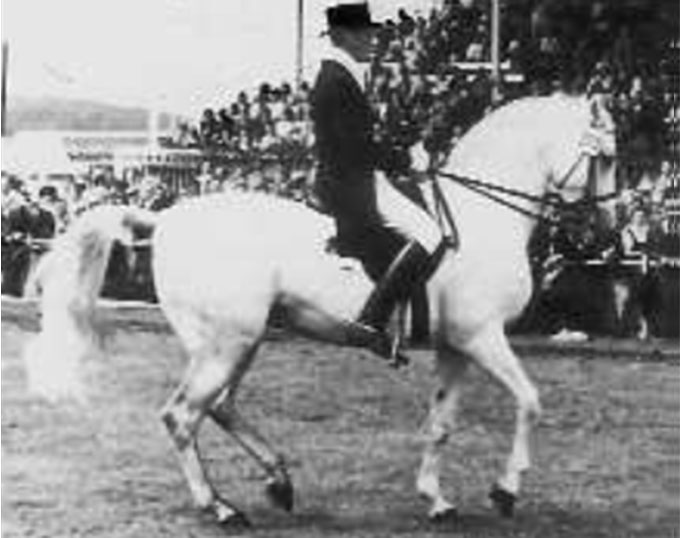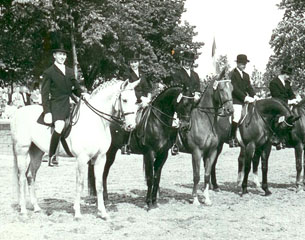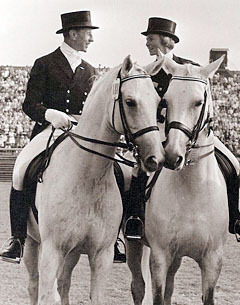
Dr. Josef Neckermann, one of Germany's most famous dressage riders and businessmen ever, always rode very good horses. Thish enabled him to be part of every German national team from 1960 through 1972. His most successful horse, Mariano, he fell in love with right away when he first saw it at the beginning of the 1960s. Howevern the fairytale-like grey with unusual Arabian flair was not for sale, so he had to wait until they found to each other.
Neckermann's dream horse was named Mariano and he was bred in 1955 in Vornholz Stud in Westfalia. There Freiherr von Nagel-Dornick bred quality dressage horses such as Adular (1956 Olympic silver and bronze) and Afrika (1956 Olympic silver), both by the original Trakehner stallion Oxyd. This lately discovered sire was also father of Mariano's dam, which was covered by the famous Anglo Arab Ramzes AA.
Four years earlier this Ramzes AA x Oxyd breeding combination had brought the Westfalian State Stud sire Radetzky, a perfectly modelled horse. Mariano was less well built. Unlike his brother he had inherited the type of the Arab much more strongly. His croup and tail were too high and his hindlegs were far from the ideal. This was the reason why his breeder sold him to Hilde Herzogin von Croy as a youngster.
Von Croy, in whose park the legendary wild horses of Dülmen lived, loved the Arabian expression of Mariano. She gave him to the professional Herbert Behrendt, who trained and improved him.
In May 1963 Behrendt showed Mariano in a pas de deux together with his pupil, Olympic rider Hannelore Weygand, during the traditional and still practised "Catch of the Dülmen Yearlings". The display ended tragically: Behrendt suffered a heart attack and fell dead off Mariano. Weygand took him over, but only for a short time. Mariano changed to Harry Boldt, who competed another Ramzes AA offspring then, Remus. Boldt was a brilliant rider, who later won two Olympic gold and two silver medals, but it just didn't click with Mariano, which was very different from Remus.

Mariano had not only inherited disadvantages of the Arabian, but also many positive qualities, which was the reason everyone was attracted by his appearance. He had a very nice topline and an Arabian head with dark eyes and the typical head line. Mariano was a real gentleman and very easy to handle in the stable. He soon became the darling of Neckermann's lontime groom Fritz Baranowski.
Neckermann also admired thise highly sensitive hopeful, but Mariano was a challenge to ride and train. He was ambitious and loved to work, but he was not forgiving at all and could be angry with his rider for days. His eagerness sometimes caused him to be hot. Because of the unfavorable angle of his hindlegs schooling the piaffe and passage first needed a lot of training to reach the right collection, but Mariano later showed them on a high level. His weak point were and remained the flying changes. He could show them perfectly, but he was never 100% reliable in this movement. As sensitive as he was, Mariano loved to present himself to an audience, the more people the better. Neckermann once even rode him in the break of a premier league football match in Frankfurt in a full stadium and his grey excellence behaved impeccably.
Neckermann didn't force Mariano at the beginning of their partnership. He didn't need to since he had another grey beauty to ride in the national team, Holstein mare Antoinette (by Anblick xx), his 1964 Olympic horse. 1966 was the year of the first official FEI World Championships in dressage held at the Swiss cavalry headquarters in Berne (EMPFA, today: NPZ). Neckermann brought both greys there, but for the reason the selector doubted Mariano's reliability so he nominated Antoinette for the team.
In these days riders were allowed to start a second horse in the Grand Prix, whose result didn't count for the team. So Neckermann won team gold on Antoinette along with Harry Boldt on Remus and Dr. Reiner Klimke on Dux and the Grand Prix itself on Mariano.
In the individual competition Neckermann competed on Mariano and they showed a ride of rare harmony and brilliance, in which the light contact with the bit was extraordinary, too. Mariano became the first Worldchampion in dressage and he obviously enjoyed the moment of honor, standing like a statue with pricked ears.

Like every competitive rider Neckermann was keen on the individual title and he knew he had a very good chance to get it. But horses are not the same each day and Mariano had one little peculiarity, which worked against him in Mexico-City: He wasn't able to manure under the saddle. When he started for his individual ride Mariano had to manure, but couldn't so he was very uncomfortable and never reached the same extraordinary form as in the Grand Prix. Neckermann tried his very best, but couldn't avoid mistakes in the tricky flying changes.
The individual gold was lost and went to Ivan Kisimov from the Soviet Union on the Ukrain bred gelding Ikhor. Neckermann was never closer to the Olympic title than on this day.
The result of the individual competition led to some discussions in the German press about the Russian training system and the way their horses went. It was compared to circus riding and critized for the lack of true collection, which allowed the Russian horses to show smooth piaffe- passage- transitions. In the opinion of many experts Mariano had had mistakes in the flying changes, but had shown true collection and shouldn't have been punished so hard.
New chances came. The first one was on home turf in Wolfsburg, where the 1969 European Championships in dressage were held. In pouring rain and under far from ideal ground conditions Mariano showed good rides and won team gold and individual bronze. But his steady success was overshone by Liselott Linsenhoff's total success on the Swedish bred stallion Piaff.

Neckermann) on Antoinette at the 1969 CDIO Aachen
Mariano shifted to a lower gear after Aachen. Neckermann's grandson Christian, a teenage boy at the beginning of the 1970s, took him over as schoolmaster and also competed him in junior competitions. Mariano lived his last years in the fields at Neckermann's property, where he only had to pay attention to Neckermann's first Olympic horse, Asbach, who didn't like his successor very much. Mariano had to be put down in 1978.
Mariano was the most successful horse of Dr. Josef Neckermann and his most difficult one.
For both reasons Mariano remained his most favourite horse of all.
By Silke Rottermann - The author likes to thank Mrs. Elisabeth Weiland for sharing her knowledge about Mariano's career in the 1960ies with her.
Recommended Read
J. Neckermann, Im starken Trab, FN- Verlag der Deutschen Reiterlichen Vereinigung, Warendorf 1992 (in German)
C.F. Mossdorf, Josef Neckermann – Olympiasieger und Weltmeister, Copress- Verlag, München 1969 (in German, out of print)
R. Klimke, F. Jandl, W. Lutz, Reiterspiele Mexiko 1968, Aschendorff Verlag, Münster 1968 (in German, out of print, available second- hand)
Related Links
Dr. Reiner Klimke's Ahlerich
Nicole Uphoff's Rembrandt: A Living Work of Art
Horse Magazine: Ramzes
www.westfalenpferde.de